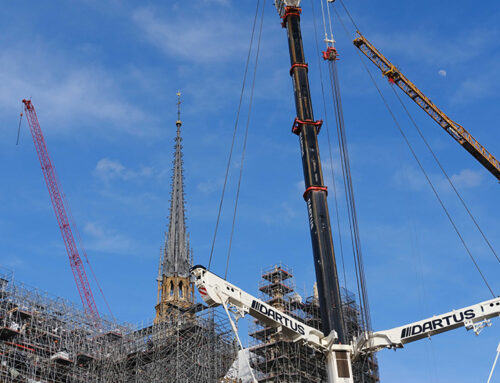A one-page article in the August 2023 issue of Wire Rope News, “Righting the Oklahoma” launched a quest: to figure out how many miles of industrial rope are used at sea.
“Righting the Oklahoma” is an interesting account of the history of the battleship USS Oklahoma, as the second oldest ship at Pearl Harbor. It was so severely damaged in the attack that it sank and remained lodged in the muddy bottom of the harbor, with only the hull exposed. It was March of 1943 before salvage efforts could begin. Engineers deployed ropes and twenty-one synchronized winches to parbuckle the USS Oklahoma into an upright position.
Envisioning this process and the role of ropes in a salvage operation wound its way to the question of how many miles of industrial rope are at sea or seaside. The scope can be monumental when the question also includes port operations, such as mooring lines and cable used in cranes. Given that one sailing ship alone, such as the USS Constitution, carries over forty miles of rope, the amount of cable and rope used on vessels around the world seems, for now, incomprehensible.
With my curiosity piqued, it was coincidental that shortly after seeing this story about the USS Oklahoma, I visited the National Museum of the Great Lakes, in Toledo, OH. Perched on the Maumee River, the museum presents fascinating displays that tell stories of the Great Lakes, ranging from geological formation to “discovery” by European explorers to their vital role in shipping and commerce.
Shipwrecks, including that of Edmund Fitzgerald, occupy a considerable section of the museum’s display area. Since the mid-1600’s, over 6,000 ships have sunk in the Great Lakes. Despite the battles on these lakes that greatly shaped their future, most of the wrecks came about by way of storms, human error in navigation, or structural flaws and damage, rather than from the drama of enemy attacks such as the USS Oklahoma endured.
Certainly, the Great Lakes have much more to offer than a rich history of shipwrecks. Yet, for those of us whose daily work centers on industrial rope, the view into the rigging used on ships throughout the centuries is well-preserved by the cold deep waters of the Lakes. It’s a view that can tell remarkable stories about the shipbuilding technology of the time and the engineering skill behind it.
Even those outside our industry take notice of the presence and use of rope and wires on ships. For example, in the Gordon Lightfoot ballad commemorating the ship and crew of the Edmond Fitzgerald, it was the ship’s rigging that received credit for sounding the alert of the “witch of November”:
“The wind in the wires made a tattle-tale sound
And a wave broke over the railing
And every man knew, as the captain did too,
T’was the witch of November come stealin’”
Lake freighters, or “Lakers” as they are called, such as the Edmund Fitzgerald, are truly enormous conveyers of economic and commercial importance. Annually, they move about 160 million tons of cargo valued at $15 billion.
It’s an understatement that ropes of all types are crucial on modern day freighters; uses of wire rope range from accommodation ladders to lifeboat and elevator wires, to mooring lines. Plus, miles of industrial rope play a role in the hoisting, moving, and lashing cargo. Despite advances in the propulsion, automation, design, and technology all associated with shipbuilding, sailing and cargo handling over the millennia, the needs for many types of reliable rope on ships are as great as ever.
Yet another example of a Great Lakes shipwreck that’s earned recent attention is the schooner, Trinidad. The discovery of this wreck was just a few months ago in July.
The Trinidad is a comparatively obscure vessel, but marine archaeologists are excited by how remarkably intact and well-preserved it is. A post about the Trinidad by the Wisconsin Historical Society describes its design as a “canaller.” The article mentions the rigging and wire rope on board, including the unique design of the davit for the lifeboats that enabled the ship to pass through the Welland Canal.
“The vessel was built for Oswego merchants John Keller and Aaron B. Merriam. TRINIDAD was a ‘canaller’ or canal schooner specially built to pass through the Welland Canal that connected Lake Erie and Ontario. As a ‘canaller’ portions of the vessel such as the lifeboat davit could specially fold in to allow the ship to traverse the canal. TRINIDAD was also outfitted with wire rigging for the masts, a feature uncommon of ships of that era.”
This post also speaks to the importance of ship maintenance, with specific mention of wire rope:
“The career of the TRINIDAD was relatively short, as the owners did not invest much money into the vessels continued upkeep. The hull was leaky, and the captain was nearly killed by a block that fell from the decaying wire rigging.”
How many miles of wire rope are at sea is the question that opened this post. We’re far away from finding an answer to that question. As impossible as it is to be on a boat or dockside without noticing the innumerable uses of rope, be it made from wire, chain, or fiber, we’ll be looking for that answer for a long time.

